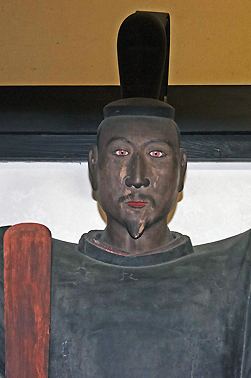Name Ashikaga Yoshimasa Children Ashikaga Yoshihisa | Siblings Ashikaga Yoshimi | |
 | ||
Similar People Ashikaga Yoshimitsu, Ashikaga Yoshihisa, Ashikaga Yoshiteru | ||
Ashikaga Yoshimasa
Ashikaga Yoshimasa (足利 義政, January 20, 1436 – January 27, 1490) was the 8th shogun of the Ashikaga shogunate who reigned from 1449 to 1473 during the Muromachi period of Japan. Yoshimasa was the son of the sixth shogun Ashikaga Yoshinori. His childhood name was Miharu (三春). His official wife was Hino Tomiko.
Contents
- Ashikaga Yoshimasa
- Temple of the Silver Pavilion
- Family
- Shogunal succession
- Events leading up to civil war
- nin War
- Yoshimasas heirs
- Higashiyama culture
- Eras of Yoshimasas bakufu
- References
On the August 16, 1443 (Kakitsu 3, 21st day of the 7th month), 10-year-old shogun Yoshikatsu died of injuries sustained in a fall from a horse. He had been shogun for only three years. Immediately, the bakufu elevated Yoshinari, the young shogun's even younger brother, to be the new shogun. Several years after becoming shogun, Yoshinari changed his name to Yoshimasa, by which name he is better known.
Temple of the Silver Pavilion
Family
Shogunal succession
Significant events which shaped the period during which Yoshimasa was shogun:
Events leading up to civil war
A number of decisions lead eventually to armed conflict:
Ōnin War
By 1464, Yoshimasa had no heir, so he adopted his younger brother, Ashikaga Yoshimi, in order to avoid any conflicts which might arise at the end of his shogunate. However, in the next year, Yoshimasa was surprised by the birth of a son, Ashikaga Yoshihisa. The infant's birth created a conflict between the two brothers over who would follow Yoshimasa as shogun. Yoshimasa's wife, Hino Tomiko, attempted to get Yamana Sōzen to support the infant's claim to the shogunate. By 1467 the simmering dispute had evolved, encouraging a split amongst the powerful daimyō and clan factions. The armed conflict which ensued has come to be known as the Ōnin War. This armed contest marks the beginning the Sengoku period of Japanese history, a troubled period of constant military clashes which would last over a century. A number of developments affect the unfolding Ōnin War's battles:
In the midst of on-going hostilities, Yoshimasa retired in 1473. He relinquished the position of Seii Taishogun to his young son who became the ninth shogun Ashikaga Yoshihisa; but effectively, Yoshimasa continued to hold the reins of power. With the leaders of the two warring factions dead and with the ostensible succession dispute resolved, the rationale for continuing to fight faded away. The exhausted armies dissolved and by 1477 open warfare ended.
Yoshimasa's heirs
When Yoshimasa declared that Yoshihisa would be the next shogun after he stepped down from that responsibility, he anticipated that his son would out-live him. When Shogun Yoshihisa died prematurely, Yoshimasa reassumed the power and responsibility he had wanted to lay aside. Shogun Yoshimasa adopted the son of his brother, Yoshimi. In 1489, shogun Yoshitane was installed; and Yoshimasa retired again.
Before Yoshimasa died in 1490, he again adopted a nephew as heir, this time the son of his brother, Masatomo. Although Yoshitane did outlive Yoshimasa, his shogunate would prove short-lived. Yoshitane died in 1493.
Also, before he married Hino Tomiko, sister of Hino Katsumitsu, he had a concubine, Lady Oima, who was 8 months pregnant when Tomiko pushed her from the stairs which resulted in a miscarriage.
Shogun Yoshimasa was succeeded by shogun Yoshihisa (Yoshimasa's natural son), then by Shogun Yoshitane (Yoshimasa's first adopted son), and then by shogun Yoshizumi (Yoshimasa's second adopted son). Yoshizumi's progeny would directly succeed him as head of the shogunate. In the future, power struggles from outside the clan would also lead to a brief period in which the great-grandson of Yoshitane would be installed as a puppet leader of the Ashikaga shogunate.
Higashiyama culture
During Yoshimasa's reign Japan saw the growth of the Higashiyama Culture (Higashiyama bunka), famous for tea ceremony (Sado), flower arrangement (Kado or Ikebana), Noh drama, and Indian ink painting. Higashiyama culture was greatly influenced by Zen Buddhism and saw the rise of Japanese aesthetics like Wabi-sabi and the harmonization of imperial court (Kuge) and samurai (Bushi) culture.
In the history of this Higashiyama bunka period, a few specific dates are noteworthy:
Eras of Yoshimasa's bakufu
The years in which Yoshimasa was shogun are more specifically identified by more than one era name or nengō.
